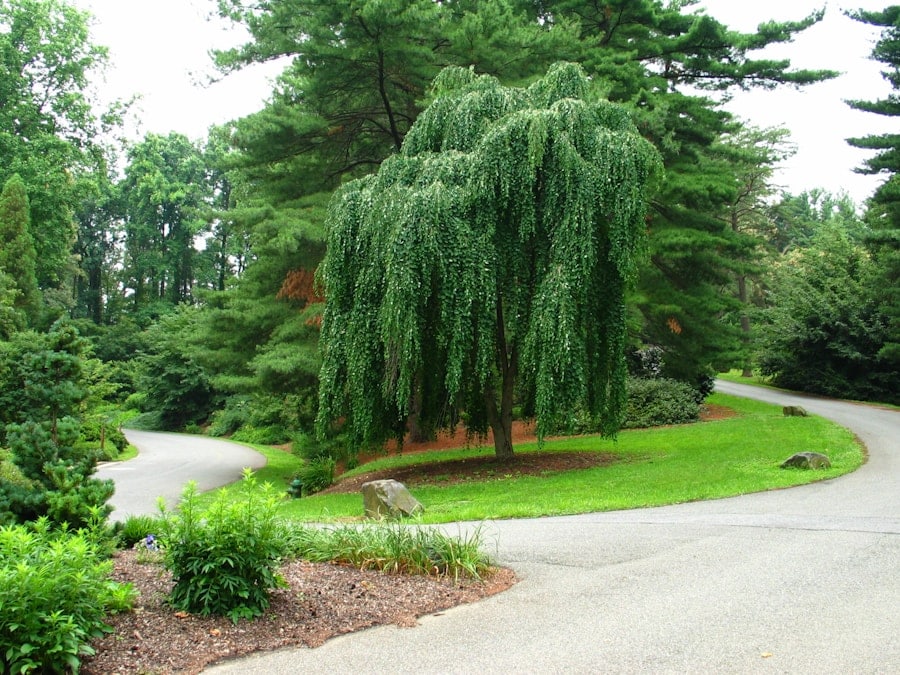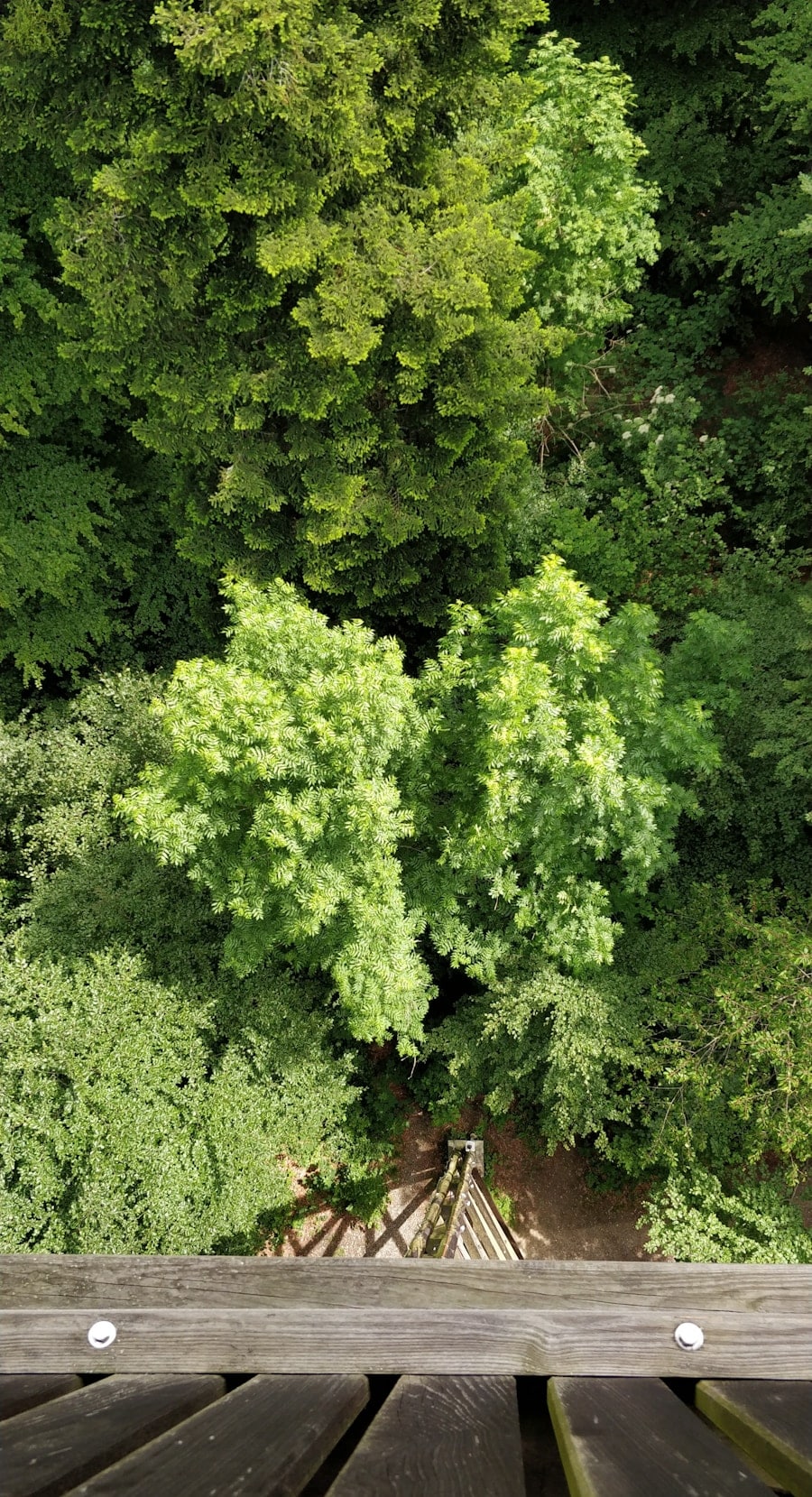Arborvitae trees, belonging to the genus Thuja, are evergreen conifers that are widely appreciated for their aesthetic appeal and functional uses in landscaping. These trees are characterized by their dense foliage, which consists of scale-like leaves that can vary in color from vibrant green to golden hues, depending on the species and variety. Arborvitae trees can grow to impressive heights, with some species reaching up to 60 feet tall, making them ideal for privacy screens, windbreaks, and ornamental hedges.
Their natural pyramidal shape and ability to maintain foliage year-round contribute to their popularity among homeowners and landscape designers alike. In addition to their visual appeal, arborvitae trees are known for their resilience and adaptability to various soil types and environmental conditions. They thrive in USDA hardiness zones 3 through 7, making them suitable for a wide range of climates across North America.
Arborvitae trees are also relatively low-maintenance, requiring minimal pruning and care once established. However, understanding their specific needs, particularly regarding nutrition and fertilization, is crucial for ensuring their health and longevity. Proper care can enhance their growth rate, improve their resistance to pests and diseases, and maintain their lush appearance throughout the seasons. Check out the latest fertilizers for your garden at Soil Compost.
Key Takeaways
- Arborvitae trees are evergreen trees that belong to the cypress family and are known for their tall, narrow shape and dense foliage.
- Fertilizing arborvitae trees is important for their growth, health, and overall appearance, as it provides essential nutrients that may be lacking in the soil.
- There are different types of fertilizers available for arborvitae trees, including granular, liquid, and slow-release formulas, each with its own benefits and application methods.
- When choosing between organic and synthetic fertilizers for arborvitae trees, consider factors such as nutrient content, environmental impact, and long-term soil health.
- The best time to fertilize arborvitae trees is in early spring before new growth begins, and again in late fall before the ground freezes, to support root development and winter hardiness.
Importance of Fertilizing Arborvitae Trees
Benefits of Fertilization
A well-fertilized arborvitae tree is more likely to exhibit robust growth, vibrant foliage, and improved resistance to diseases and pests. Moreover, fertilization plays a critical role in enhancing the aesthetic qualities of arborvitae trees. Healthy trees with adequate nutrition tend to have denser foliage and a more vibrant color, contributing to the overall beauty of the landscape.
Environmental Resilience
In addition, properly fertilized arborvitae trees can better withstand environmental stressors such as drought or extreme temperatures. This resilience is particularly important in urban settings where soil quality may be compromised or where trees face competition from nearby structures or other vegetation.
Year-Round Health and Beauty
By providing the right nutrients at the right time, gardeners can ensure that their arborvitae trees remain healthy and visually appealing throughout the year.
Types of Fertilizers for Arborvitae Trees

When it comes to fertilizing arborvitae trees, there are several types of fertilizers available, each with its own unique composition and benefits. The most common categories include granular fertilizers, liquid fertilizers, and slow-release fertilizers. Granular fertilizers are often favored for their ease of application and long-lasting effects.
They can be spread around the base of the tree and will gradually release nutrients into the soil as they break down over time. This slow-release characteristic makes them ideal for providing a steady supply of nutrients throughout the growing season. Liquid fertilizers, on the other hand, offer a quick nutrient boost and are typically used for immediate results.
They can be applied directly to the soil or as a foliar spray, allowing for rapid absorption by the tree. This type of fertilizer is particularly useful during periods of active growth or when trees show signs of nutrient deficiency. Additionally, slow-release fertilizers combine the benefits of both granular and liquid forms by providing nutrients over an extended period while minimizing the risk of nutrient leaching.
These fertilizers are often coated with a polymer that controls the release rate based on temperature and moisture levels in the soil. The choice between organic and synthetic fertilizers is a significant consideration for those caring for arborvitae trees. Organic fertilizers are derived from natural sources such as compost, manure, bone meal, or fish emulsion.
They not only provide essential nutrients but also improve soil structure and promote beneficial microbial activity in the soil. This can lead to healthier root systems and enhanced nutrient uptake over time. Organic fertilizers tend to release nutrients more slowly than synthetic options, which can be advantageous for long-term soil health but may require more frequent applications.
In contrast, synthetic fertilizers are manufactured through chemical processes and typically contain concentrated forms of nutrients such as nitrogen, phosphorus, and potassium. These fertilizers can deliver immediate results and are often more cost-effective than organic alternatives. However, they may pose risks if not applied correctly; excessive use can lead to nutrient runoff and environmental pollution.
Additionally, synthetic fertilizers do not contribute to soil health in the same way that organic options do. Ultimately, the choice between organic and synthetic fertilizers will depend on individual preferences, gardening philosophies, and specific needs of the arborvitae trees being cared for.
Best Time to Fertilize Arborvitae Trees
| Factors | Best Time to Fertilize |
|---|---|
| Soil Temperature | When soil temperature reaches 55-60°F (13-16°C) in spring |
| Growth Stage | Early spring before new growth starts or late fall after growth has stopped |
| Fertilizer Type | Slow-release balanced fertilizer with a 10-10-10 or 12-6-6 NPK ratio |
| Moisture Level | When soil is moist but not waterlogged |
| Tree Age | For young trees, fertilize once a year; for mature trees, fertilize every 2-3 years |
Timing is crucial when it comes to fertilizing arborvitae trees to ensure optimal nutrient uptake and growth. The best time to fertilize these trees is typically in early spring before new growth begins or in late fall after the growing season has ended. In early spring, as temperatures begin to rise and soil moisture increases, arborvitae trees start to actively grow again.
Applying fertilizer at this time provides the necessary nutrients that support new leaf development and overall vigor as they emerge from dormancy. Late fall fertilization can also be beneficial as it allows trees to absorb nutrients before entering winter dormancy. This practice helps prepare them for the upcoming growing season by ensuring that they have adequate nutrient reserves stored in their roots.
However, it is essential to avoid fertilizing during periods of extreme heat or drought, as this can stress the trees further and hinder their ability to absorb nutrients effectively. Understanding the specific growth cycles of arborvitae trees in your region will help determine the most appropriate timing for fertilization.
How to Apply Fertilizer to Arborvitae Trees
Granular Fertilizers
For granular fertilizers, it is advisable to spread the granules evenly around the base of the tree while avoiding direct contact with the trunk. A general rule of thumb is to apply fertilizer at a distance equal to the tree’s height from the trunk outward; this ensures that nutrients reach the root zone without risking burn or damage to the bark.
Liquid Fertilizers
When using liquid fertilizers, dilution according to package instructions is crucial for preventing root burn or other adverse effects. Liquid fertilizers can be applied using a watering can or a garden sprayer directly onto the soil around the tree’s base or as a foliar spray on the leaves during active growth periods.
Post-Application Care
Regardless of the type of fertilizer used, it is essential to water thoroughly after application to help dissolve the nutrients and facilitate their absorption by the roots.
Signs of Over-Fertilizing Arborvitae Trees

Over-fertilization can have detrimental effects on arborvitae trees, leading to various symptoms that indicate an excess of nutrients in the soil. One common sign is excessive leaf growth accompanied by a pale or yellowish color; this phenomenon occurs when nitrogen levels are too high relative to other essential nutrients like potassium or phosphorus. In some cases, over-fertilized trees may exhibit stunted growth despite abundant foliage due to nutrient imbalances that hinder overall health.
Another indicator of over-fertilization is increased susceptibility to pests and diseases. Trees that are stressed from nutrient overload may become weakened and more vulnerable to infestations by insects such as spider mites or aphids.
Recognizing these signs early on allows gardeners to adjust their fertilization practices accordingly and restore balance within their arborvitae trees.
Tips for Maintaining Healthy Arborvitae Trees
Maintaining healthy arborvitae trees involves more than just proper fertilization; it requires a holistic approach that encompasses watering practices, pruning techniques, and pest management strategies. Regular watering is essential during dry spells or periods of drought; however, it is crucial not to overwater as this can lead to root rot or other moisture-related issues. A deep watering approach encourages deep root growth while allowing the top layer of soil to dry out between sessions.
Pruning is another vital aspect of maintaining arborvitae health. While these trees generally require minimal pruning, removing dead or damaged branches can improve air circulation and reduce disease risk. Additionally, shaping young trees can help establish a strong structure that supports healthy growth as they mature.
Monitoring for pests regularly is also important; early detection allows for timely intervention using organic or chemical controls as needed. In conclusion, understanding how to care for arborvitae trees through proper fertilization practices is essential for promoting their health and longevity in any landscape setting. By recognizing their specific needs regarding nutrition and timing while being mindful of potential pitfalls such as over-fertilization or pest infestations, gardeners can cultivate thriving specimens that enhance both beauty and functionality within their outdoor spaces.
When determining the best fertilizer for arborvitae trees, it is important to consider the specific needs of these evergreen plants.

